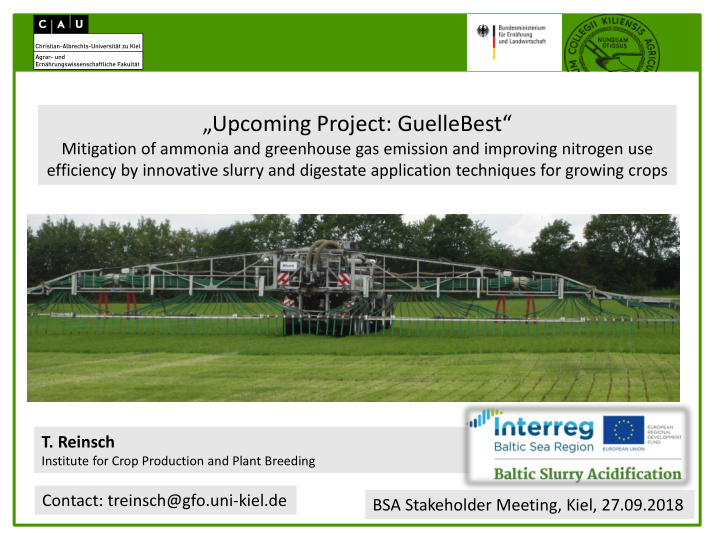



„ Upcoming Project: GuelleBest “ Mitigation of ammonia and greenhouse gas emission and improving nitrogen use efficiency by innovative slurry and digestate application techniques for growing crops T. Reinsch Institute for Crop Production and Plant Breeding Contact: treinsch@gfo.uni-kiel.de BSA Stakeholder Meeting, Kiel, 27.09.2018
Background (Taube et al., 2015) ⌀ SH: 118 kg N/ha Nord- fries- Schleswig- land Flensburg 159 149 115 88 Ost- Rendsburg- Dith- holstein Eckernförde Plön marschen 68 129 124 Steinburg 113 Segeberg Stor- Pinne- (kg N/ha) marn berg 111 Herzogtum < 80 85 Lauen- burg 80-100 84 100-120 120-140 > 140 Gross-N-losses per ha UAA in the state of Schleswig-Holstein (Germany) Currently the losses of nitrogen in agricultural production account > 100 kg/ha UAA, at which 30% could be easily avoided 2 (Taube et al., 2015) (~ 30.000 tons nitrogen in S-H).
Background (UBA, 2018) Reduction aim (2030) ca. 440 Gg • Germany has to decrease the ammonia emissions until 2030 by 29% (NERC-Directive) • Due to imrovements of the german fertilizer ordinance according to the EU-Nitrate Directive (2018) almost no application of manures after harvest are performable. • During spring no incorporation possible in winter crops. • The use of BAT („ best availbale techniques “) for slurry application is obligatory by law until 2020 for arabel and 2025 for grassland. (Rösemann et al. 2017)
Background Ammonia emissions from agriculture in Germany Mineral fertilizer Application digestates Application slurry Storage Shed Pasture • Slurry application has the highest reduction potential for ammonia emissions in Gemany.
Background Mitigation strategies: • Reduction of ammonia emissions during application in standing biomass • Highest potential for cattle slurry and digestates in Germany The large the substrate surface the larger the ammonia emissions Emission reduction • Current application techniques used in compared to Germany: broadcast application Trailing hoses 30% Incorporation Trailing shoe 40% Injection Trailing shoe Injection 60% Trailing hoses Broadcast with Broadcast 55% acidification NH 3 – emissions with broadcast (KTBL, 2016a) application up to 80% of NH4-N.
GuelleBest Project Call: Mitigation of ammonia and greenhouse gas emission and improving nitrogen use efficiency by innovative slurry and digestate application techniques for growing crops Acronym: GuelleBest Duration: 2019-2021 Funding: ~1.5 Mio €
GuelleBest partners LWK S.-H. Christian-Albrechts-Universität LLUR DK (Viborg) LWK Niedersachsen Hochschule Osnabrück Thünen-Institut (lead) LTZ Augustenburg Universität Hohenheim Universities Public bodies Steakholders Experimental farms Pilotfarms
GuelleBest Work-Packages (WP) (2019-2022) WP1 Network of co-ordinated field trials to reduce greenhouse gas and ammonia emissions from growing crops WP3 WP2 Economy on farm-scale Assesment of GHG-emissionis WP4 Prediction of impact on the national inventories WP5 Joint assessment, transfer of knowledge into practice
GuelleBest field trials (2019-2022) Winter-Wheat Permanent Grassland Site Avg. Air Annual Freezing Soil pH Project- temp rainfall days Partner (°C) (mm a‐1) Schleswig- 8.9 732 33 Sandy loam 6.7 CAU Holstein I 8.8 826 33 Loamy sand 5.4 CAU Lower Saxony 9.0 837 55 Sandy loam 5.5 University Osnabrück Baden- 8.8 686 91 clay 6.8 University Württemberg Hohenheim
GuelleBest field trials (2019-2022) Treatments and measurements Winter Wheat Grassland Control 1,2,3 Control 1,2,3 1 1 2 Mineral fertilizer - CAN 1,2,3 2 Mineral fertilizer: CAN 1,2,3 Slurry trailing hoses 1,2,3 Slurry trailing shoe 1,2,3 3 3 Slurry acidification trailing hoses 1,2,3 Slurry acidificataion trailing shoes 1,2,3 4 4 Slurry injection 1, 2, 3, 4 Slurry injection 1,2,3, 5 5 Slurry injection + nitirification inhibitor 1, 2, 3, 4 Slurry injection + nitirification inhibitor 1,2,3, 6 6 7 Digestates trailing hoses 2 Digestates acidificataion trailing hoses 2 8 Digestates injection 12, 4 9 Maximum rate of slurry N: 170 10 Digestates injection + nitirification inhibitor 2, kg applied in two dressings! 4 1 NH 3 -measurements with the Dräger-Tube-Method 2 NH 3 -measurements with acid traps 3 N 2 O-measurements with the static chamber method 4 In winter-wheat the first slurry dressing will be performed with injection and the second with trailing hoses
Former techniques will be improved in order to test the different application techniques Slurry dressings will be performed with representative techniques to ensure comparibility and up-scaling of results.
Methods DM-Yield, N-Yield and forage quality will be estimated for each silage cut and winter wheat harvest respectively
Methods ➢ Nitrous Oxide will be measured in minimum once a week for 365 days
Methods ➢ Ammonia measurments will be quantified for >7 days after fertilizer application Dräger-Tube-Method Passive-Sampler
Knowledge-transfer Vielen Dank für ihre Aufmerksamkeit! Kontakt: mailto:treinsch@gfo.uni-kiel.de
Recommend
More recommend